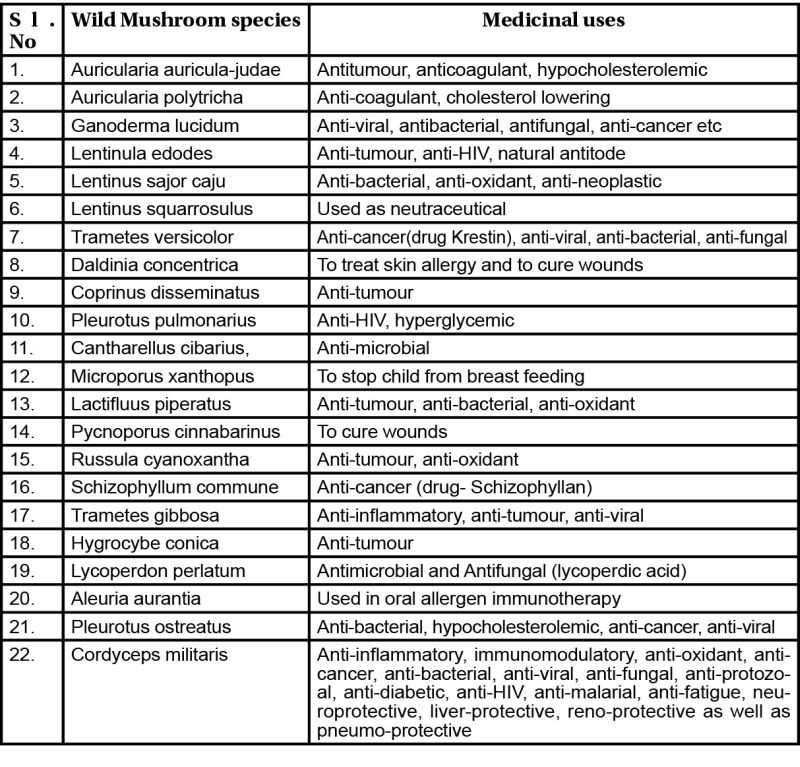Table: Medicinal properties of some mushrooms collected from Nagaland

Dr Toshinungla Ao
Mushrooms are known to mankind since early human civilization. Presently, this mushroom is everywhere in the world and can be considered as a global celebrity. The global domination of mushrooms as an important food is worth knowing why it is. They are gaining importance because of their nutritional and medicinal properties. Nagaland is also home for many wild edible mushrooms (WEM) including medicinal species (Ao & Deb, 2019).
Mushrooms belong to Kingdom Fungi and are classified under classes of Ascomycetes and Basidiomycetes. Mushrooms have a distinctive fruiting body in the form of brackets, bird’s nest, jelly, boletes, corals, puffballs, stinkhorns and agarics. They are fleshy, leathery, sub-fleshy or woody and their fertile surface is found attached on lamellae or the tubes (Deshmukh 2004).
Mushrooms have always been used as a nutritious source of food and popularly known for its medicinal properties. The importance of mushrooms was initially discovered by the Chinese and the Egyptians. Edible mushrooms are considered to be health food as they are rich in proteins, minerals, vitamins, fibers, low/no calories and cholesterol lowering properties (Wani et al. 2010). Barros et al. (2008) considered wild mushrooms to be richer source of proteins and low fat content as compared to commercial mushrooms. The presence of secondary metabolites in mushrooms like polyphenols, terpenes, steroids and polyketides which have antioxidant properties and pharmacological applications play important role in maintaining the health of consumers (Barros et al. 2007). Patel and Goyal (2013) reported that mushrooms act as anti-cancer compounds, plays crucial role as reactive oxygen species inducer, mitotic kinase inhibitor, anti-mitotic, angiogenesis inhibitor, topoisomerase inhibitor, leading to apoptosis and also checking cancer proliferation. Most organisms possess antioxidant defense and repair systems for protection against free radical damage by oxidative enzymes like superoxide dismutase (SOD) and catalase (CAT) and by chemical compounds like ascorbic acid, carotenoids, α-tocopherol, glutathione and polyphenolic compounds (Mau et al. 2001), yet these systems are not sufficient. Natural sources of antioxidants are extensively studied for their properties to protect organisms and cells from damage brought about by oxidative stress.
Conservation of macro-fungi has garnered added interest during the last two decades because of the growing demand and need for organic food. Even the market value of mushrooms has increased tremendously recently. Unfortunately, the survival of mushrooms is under threat due to various developmental activities of humans like urbanization, deforestation, unsystematic exploration and climate change etc. Studies on mushroom diversity and taxonomy are receiving much attention because mushrooms are on the verge of extinction (Bhattacharjee et al., 2015).
Wild mushrooms are important non-wood forest resource which provides seasonal food and also alternative source of income to the rural people (Sysouphanthong et al., 2010). Over the years, the demand for both edible and medicinal mushrooms has increased; but unfortunately mushroom research has not progressed accordingly. The fungal diversity studies carried out world over estimates the number of mushrooms on earth to be approximately 140,000 yet only 10% are known from this (Wasser, 2002). It is said that India is home to about one third of the global fungal diversity but only 50% are characterized approximately (Manoharachary et al., 2005). These macro fungi have the oldest history of the diversity studies in comparison to any mycota over the world, but are still understudied.
Ikekawa et al. (1969) and Chihara et al. (1969) were amongst the early workers who uncovered the medicinal properties like the anti-tumor activity of mushrooms. Many mushrooms have been traditionally used in China, Korea and Japan for their medicinal and tonic properties. Examples include Auricularia species (wood ear mushrooms) which have traditionally been used to treat piles and various stomach ailments; Tremella fusiformis (jelly fungus) for maintaining healthy lung tissue; Hericium erinaceus (monkey head mushroom) for treating gastric ulcers; Volvariella volvacea (straw mushroom) for lowering blood pressure and accelerating the healing of wounds and Lentinula edodes (shiitake) in the prevention of rickets and relief of excess gastric acidity (Chang, 1996). Mushrooms are alternative sources of antimicrobial compounds and secondary metabolites like steroids, anthraquinones, terpenes, derivatives of benzoic acid, and quinolones; and primary metabolites like peptides, oxalic acid and proteins. Lentinus edodes is amongst the most researched macro fungi having antimicrobial effects on both gram-positive and gram-negative bacteria (Alves, 2012). Powdered extract from some species have indicated the presence of essential nutrients. These nutrients can be used in low-calorie diets. Some formulations have antioxidants properties and can be used to prevent the oxidative stress and hence ageing (Valverde et al., 2015). The medicinal mushrooms are important for health because they exhibit a wide range of pharmacological properties – antioxidative, hepatoprotective, anti-allergic, anti-inflammatory, antibacterial, antiviral, anti-diabetic, antifungal, cytotoxic, anti-depressive, hypotensive, immunomodulating, nephroprotective, anti-hyperlipidemic, neuroprotective, and osteoprotective activities. Though for progress in mycotherapy, it will require great efforts and determination from the researchers and scientists working in the field (Venturella et al., 2021). These medicinal mushrooms are reportedly used in the study and treatment of oncology, for their antitumor and immunomodulatory activities which complements the traditional treatments, reducing side effects and improving their mode of action (Guggenheim et al., 2014; Wasser, 2014; Jeitler et al., 2020).
About India
Due to the diverse geographical, climatic and ecological conditions, India is home to a million fungal species. Mushroom explorations in Rajasthan, Eastern Himalayan, Indo Gangetic Plain, Northwest Himalayan, Western Ghats and Southern India have already been carried out throughout the country by different workers as hotspots of mushroom, since 1825 (Borkar et al., 2015). These factors combined make India a potential major producer of temperate, tropical and subtropical mushroom species. There is the urgency to undertake investigations of the Indian mushrooms for its bioactivity, which are used in the treatment of diseases like AIDS, cancer, etc. (Deshmukh, 2006). Ajith and Janardhanan (2007) reported the anti-tumor and antioxidant activities of some South Indian mushrooms. Vishwakarma et al. (2011) reported the medicinal wild mushrooms from Garhwal Himalaya, Uttarakhand. The North-Eastern region of India being the transitional zone between the Indian, Indo-Malayan and Indo-Chinese bio-geographical regions makes the gate way for many of India’s flora and fauna. The region comprises of the states- Mizoram, Tripura, Assam, Meghalaya, Arunachal Pradesh, Manipur, Nagaland and Sikkim. Northeast India is among the top 36 global biodiversity hotspots of the world and is very rich in mushroom flora. The region also has very high level of endemism and is considered as an important sub-centre for mushroom origin, the most important macro fungi. In the Western regions of the world, mushrooms have already been studied extensively, but in the tropical regions like India especially the North-East India is less explored. Therefore, it is high time to carry out extensive and intensive explorations to document and conserve this valuable natural bioresource. The state of Nagaland is very rich in biodiversity including the mushrooms (Ao et al., 2016a; Ao et al., 2016b; Ao et al., 2019; Ao & Deb (2019a); Ao & Deb (2019b); Ao & Deb (2019c); Ao & Deb (2021).
There has been tremendous progress in mushroom cultivation and research because of its nutritional and medicinal properties. These wild edible mushrooms are healthy food supplements required to maintain balanced diets as it contains macro as well as micro nutrients and functional minerals. It is highly popular as a low caloric diet food especially for cancer, diabetic and cardiac patients. Moreover, mushrooms are gaining importance as a protein supplementary food for the people especially living in under developed countries. The State of Food Security and Nutrition in the World (SOFI) has called upon all countries and stakeholders to act together to end hunger and prevent all forms of malnutrition by 2030 as the present scenario is that the number of undernourished people in the world is increasing alarmingly.
Thus, the present article creates awareness about the nutritional and medicinal importance of mushrooms. These mushrooms have the solution to some extent on many of the present day problems like food quality, unemployment, environmental pollutions and pharmaceutical applications. Mushrooms as food and medicines are solutions to many health problems. However, extensive explorations and thorough screening of the wild mushrooms is the need of the hour as mushrooms are valuable natural resource to mankind with immense health benefits and should be exploited judiciously for the betterment of society.
Sources: Chang and Miles, 2004; Das, 2010; Das et al., 2010; Deshmukh, 2004; Dulger et al., 2004; Manoharachary et al., 2005; Patel et al., 2012; Sachan et al., 2013 and present work of the author.
The author is thankful to Professor Chitta Ranjan Deb; Head, Botany Department, Nagaland University; Coordinator of DBT sponsored Institutional Biotech Hub; SAP-DRS (III) programme & Coordinator of DST-FIST programme for her
Ph.D programme.
The author is a Ph D (Molecular Biology, Genetic Diversity, Biochemical Analysis, Mushroom Taxonomy, Nagaland)
St John College, Dimapur




